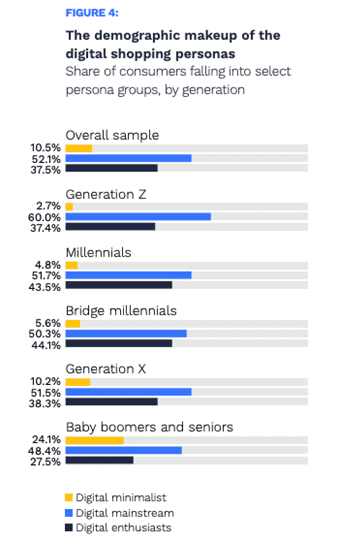3 Distinct ‘Digital Shopping Personas’ Offer Retailers Fresh Insights on Buying

Shopper’s digital personas are crucial to recognizing new revenue opportunities, so retailers need to acquaint themselves with these groupings.
Now in its third year, The 2023 Global Digital Shopping Index, a PYMNTS and Cybersource collaboration, finds that as the pandemic acceleration of digital shopping behaviors seeks its level in six nations studied, defined personas have emerged in consumers’ use of digital tools.
Let’s meet those personas.
Across the nearly 13,350 consumers and 3,124 merchants from Brazil, India, Mexico, the United Arab Emirates, the United Kingdom, and the United States surveyed for this study, the largest persona group is what we term “Digital Mainstream Consumers.”

Representing just over half (52%) of the entire six-nation sample, Digital Mainstream shoppers “are the most drawn to digital features that give them more insight into the items they buy and make that shopping process easier, including mobile-optimized apps, product reviews and free shipping,” the study stated.
We see greater concentrations of Digital Mainstream shoppers in still-emerging economies including Brazil (54.8%), India (54.7%), Mexico (58.2%), and the United Arab Emirates (57.8%).
Somewhat curiously, it’s the U.S. (47.5%) and the U.K. (46%) with the fewest shoppers falling into the Digital Mainstream, which can be tied to retailers pulling back on some pandemic-era practices like free shipping and guaranteed refunds in those regions.
The next most widely dispersed persona we identified is the “Digital Enthusiast Consumer.” As the wording suggests, these shoppers are device-laden, data-informed, and tend to be the early adopters of digital shopping tools from buy now pay later to digital wallets.
By country, India leads in the number of Digital Enthusiasts (45.2%), followed by the U.K. (39.7%), with a statistical dead-heat between the U.S. (33.5%) and Brazil (33%).
Mexico (28.6%) is slightly ahead of the UAE (28.1%) in this segmentation.
The third and final category of shoppers we define as “the Digital Minimalist.” As the study notes, minimalists “primarily engage digitally with the features that more highly correlate to their offline habits: coupons, rewards and promotions and preferred payments availability.”
Somewhat curiously, India has the highest number of digital enthusiasts among our survey sample, as none in this densely populated nation identified as digital minimalists. However, a study footnote states that “our survey of consumers in India included only individuals who could read and write in either Hindi or English. Our sample may therefore hold an inherent bias toward the 74% of consumers in India who have these skills.”
The Demographic Breakdowns
The largest grouping — Digital Mainstream shoppers — at 52% of the entire global sample equals roughly 223 million consumers around the world that have now made digital a regular part of their shopping and payment routines.

Demographically dominated by Gen Z consumers at 60% of the entire sample, roughly 36 million across all six countries fall into this grouping.
Millennials (51.7%), Gen X (51.5%), and bridge millennials (50.3%) are evenly represented among digital mainstream shoppers and are mostly found in Mexico (58.2%) and the UAE (57.8%).
The smallest category we measured is digital minimalists, at just 10.5% of the global sample. Baby Boomers and Seniors dominate this grouping, with over one-quarter (24.1%) identifying as minimalists.
Compare that to just 2.7% of Gen Z consumers who call themselves digital minimalists, followed by millennials (4.8%) and bridge millennials (5.6%).
Digital enthusiasts who like doing as much shopping as they can via smartphones, apps, and digital wallets “are most commonly found among bridge millennials, a unique cohort of consumers between 33 and 44 years old who thus ‘bridge the gap’ between Generation X and millennials. These consumers came of age with laptops and smartphones in hand and are comfortable using digital-first methods to shop and pay, whether via a digital wallet, cryptocurrency, or otherwise,” per the study.
The new study contains revealing persona sketches of shoppers in different nations and how they engage in digital shopping and related behaviors, which are informative to companies throughout the global ecosystem of digital shopping and payments.
Get Your Copy: The 2023 Global Digital Shopping Index
For all PYMNTS retail coverage, subscribe to the daily Retail Newsletter.
